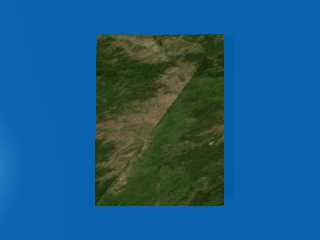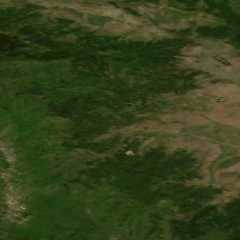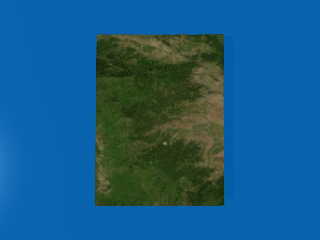 |
 |
|
 |
|
 |
|  |
|  |
|
 |
|
 |
|  |
|  |
|
 |
Hi(gh)!
Meanwhile, I fixed mesh2writer.pov and placed the global flattening of
the mesh2 object into povearth.pov... but now another problem showed up:
the terrain texture is strangely distorted, as if in each line of
vertices, one texture sample is omitted (see attachment).
The respective code in mesh2writer.pov:
// begin code
#if (!(tilename="n80e014" | tilename="n80e016" | tilename="n80e017")) //
for elevation data tiles north of 80°N, no Blue Marble texture tiles are
available!
#declare i=0;
#write (ES, " texture_list")
#write (ES, " {\n")
#write (ES, concat(" ",str(NumTextures, 1, 0),"\n"))
#for (a, 0, ydim-1)
#for (b, 0, xdim-1)
#declare C_Texture = eval_pigment(P_Texture,
<(0.5+b)*(1/(xdim-1)), (0.5+a)*(1/(ydim-1)), 0>);
// #warning concat("Iteration ", str(a, 1, 0), "-", str(b, 1, 0))
#write (ES, " texture\n")
#write (ES, " {\n")
#write (ES, " pigment\n")
#write (ES, " {\n")
#write (ES, concat(" color rgb <",vstr(3, C_Texture, ",", 1,
7),">\n"))
#write (ES, " }\n")
#write (ES, " }\n")
// #declare c=c+1;
#end
#end
#write (ES, " }\n")
#end
// end code
I tried to replace xdim-1 and ydim-1 with xdim and ydim respectively,
but then got the error message "missing }, texture found instead" -
obviously, NumTextures is exceeded. But when I in fact use the full xdim
and ydim values, shouldn't there be a black last column and row?
See you in Khyberspace!
Yadgar
Post a reply to this message
Attachments:
Download 'tbilisi.png' (320 KB)
Preview of image 'tbilisi.png'

|
 |
|  |
|  |
|
 |
|
 |
|  |
|  |
|
 |
hi,
=?UTF-8?Q?J=c3=b6rg_=22Yadgar=22_Bleimann?= <yaz### [at] gmx de> wrote:
> Hi(gh)!
>
> Meanwhile, I fixed mesh2writer.pov and placed the global flattening of
> the mesh2 object into povearth.pov... but now another problem showed up:
> the terrain texture is strangely distorted, as if in each line of
> vertices, one texture sample is omitted (see attachment).
out of interest, what does 'P_Texture' look like?
> ... But when I in fact use the full xdim
> and ydim values, shouldn't there be a black last column and row?
that would be my expectation too. the code looks kosher, have you tried with
same code but different data tile/set?
regards, jr. de> wrote:
> Hi(gh)!
>
> Meanwhile, I fixed mesh2writer.pov and placed the global flattening of
> the mesh2 object into povearth.pov... but now another problem showed up:
> the terrain texture is strangely distorted, as if in each line of
> vertices, one texture sample is omitted (see attachment).
out of interest, what does 'P_Texture' look like?
> ... But when I in fact use the full xdim
> and ydim values, shouldn't there be a black last column and row?
that would be my expectation too. the code looks kosher, have you tried with
same code but different data tile/set?
regards, jr.
Post a reply to this message
|
 |
|  |
|  |
|
 |
|
 |
|  |
|  |
|
 |
"jr" <cre### [at] gmail com> wrote:
> ...
> that would be my expectation too. the code looks kosher, have you tried with
> same code but different data tile/set?
actually, belay that. :-) sorry, noise, etc..
the increments where you make the vector for 'eval_pigment', pretty sure you'll
want '<(.5+b)*(1/xdim), (.5+a)*(1/ydim),0>'.
regards, jr. com> wrote:
> ...
> that would be my expectation too. the code looks kosher, have you tried with
> same code but different data tile/set?
actually, belay that. :-) sorry, noise, etc..
the increments where you make the vector for 'eval_pigment', pretty sure you'll
want '<(.5+b)*(1/xdim), (.5+a)*(1/ydim),0>'.
regards, jr.
Post a reply to this message
|
 |
|  |
|  |
|
 |
From: Jörg "Yadgar" Bleimann
Subject: Re: POVEarth: Distorted Terrain Texture
Date: 13 Aug 2020 18:29:49
Message: <5f35bedd$1@news.povray.org>
|
|
 |
|  |
|  |
|
 |
Hi(gh)!
On 13.08.20 21:03, jr wrote:
> "jr" <cre### [at] gmail com> wrote:
>> ...
>> that would be my expectation too. the code looks kosher, have you tried with
>> same code but different data tile/set?
>
> actually, belay that. :-) sorry, noise, etc..
>
> the increments where you make the vector for 'eval_pigment', pretty sure you'll
> want '<(.5+b)*(1/xdim), (.5+a)*(1/ydim),0>'.
As the data tile is square, xdim = ydim! Of course you're right, if I
ever wanted to render a non-square data set, it's better to have the two
variables assigned to the proper dimensions.
See you in Khyberspace!
Yadgar com> wrote:
>> ...
>> that would be my expectation too. the code looks kosher, have you tried with
>> same code but different data tile/set?
>
> actually, belay that. :-) sorry, noise, etc..
>
> the increments where you make the vector for 'eval_pigment', pretty sure you'll
> want '<(.5+b)*(1/xdim), (.5+a)*(1/ydim),0>'.
As the data tile is square, xdim = ydim! Of course you're right, if I
ever wanted to render a non-square data set, it's better to have the two
variables assigned to the proper dimensions.
See you in Khyberspace!
Yadgar
Post a reply to this message
|
 |
|  |
|  |
|
 |
From: Jörg "Yadgar" Bleimann
Subject: Re: POVEarth: Distorted Terrain Texture
Date: 13 Aug 2020 18:50:33
Message: <5f35c3b9@news.povray.org>
|
|
 |
|  |
|  |
|
 |
Hi(gh)!
On 13.08.20 20:55, jr wrote:
> out of interest, what does 'P_Texture' look like?
See first attachment!
>
>> ... But when I in fact use the full xdim
>> and ydim values, shouldn't there be a black last column and row?
>
> that would be my expectation too. the code looks kosher, have you tried with
> same code but different data tile/set?
No, I didn't... but meanwhile, I experimented with various values for
the loop and NumTextures, finally ended up with xdim-2 respectively
ydim-2, which is (xdim-1)*(ydim-1) for NumTextures, which did the trick
(see second attachment)!
See you in Khyberspace!
Yadgar
Post a reply to this message
Attachments:
Download 'n41e044_2004-07.png' (74 KB)
Download '2020-08-14 tbilisi area, take 4 - overview from 200 kms altitude.jpg' (42 KB)
Preview of image 'n41e044_2004-07.png'

Preview of image '2020-08-14 tbilisi area, take 4 - overview from 200 kms altitude.jpg'

|
 |
|  |
|  |
|
 |
From: Alain Martel
Subject: Re: POVEarth: Distorted Terrain Texture
Date: 13 Aug 2020 20:50:52
Message: <5f35dfec@news.povray.org>
|
|
 |
|  |
|  |
|
 |
Le 2020-08-13 à 11:43, Jörg "Yadgar" Bleimann a écrit :
> Hi(gh)!
>
> Meanwhile, I fixed mesh2writer.pov and placed the global flattening of
> the mesh2 object into povearth.pov... but now another problem showed up:
> the terrain texture is strangely distorted, as if in each line of
> vertices, one texture sample is omitted (see attachment).
>
> The respective code in mesh2writer.pov:
>
> // begin code
>
> #if (!(tilename="n80e014" | tilename="n80e016" | tilename="n80e017")) //
> for elevation data tiles north of 80°N, no Blue Marble texture tiles are
> available!
> #declare i=0;
> #write (ES, " texture_list")
> #write (ES, " {\n")
> #write (ES, concat(" ",str(NumTextures, 1, 0),"\n"))
> #for (a, 0, ydim-1)
>
> #for (b, 0, xdim-1)
> #declare C_Texture = eval_pigment(P_Texture,
> <(0.5+b)*(1/(xdim-1)), (0.5+a)*(1/(ydim-1)), 0>);
> // #warning concat("Iteration ", str(a, 1, 0), "-", str(b, 1, 0))
> #write (ES, " texture\n")
> #write (ES, " {\n")
> #write (ES, " pigment\n")
> #write (ES, " {\n")
> #write (ES, concat(" color rgb <",vstr(3, C_Texture, ",",
> 1, 7),">\n"))
> #write (ES, " }\n")
> #write (ES, " }\n")
> // #declare c=c+1;
> #end
> #end
> #write (ES, " }\n")
> #end
>
> // end code
>
> I tried to replace xdim-1 and ydim-1 with xdim and ydim respectively,
> but then got the error message "missing }, texture found instead" -
> obviously, NumTextures is exceeded. But when I in fact use the full xdim
> and ydim values, shouldn't there be a black last column and row?
>
> See you in Khyberspace!
>
> Yadgar
Looks like one image was taken late summer during a drought and the
other in late rainy spring.
Post a reply to this message
|
 |
|  |
|  |
|
 |
|
 |
|  |
|  |
|
 |
hi,
=?UTF-8?Q?J=c3=b6rg_=22Yadgar=22_Bleimann?= <yaz### [at] gmx de> wrote:
> On 13.08.20 21:03, jr wrote:
> > "jr" <cre### [at] gmail de> wrote:
> On 13.08.20 21:03, jr wrote:
> > "jr" <cre### [at] gmail com> wrote:
> >> ...
> > the increments where you make the vector for 'eval_pigment', pretty sure you'll
> > want '<(.5+b)*(1/xdim), (.5+a)*(1/ydim),0>'.
>
> As the data tile is square, xdim = ydim! Of course you're right, if I
> ever wanted to render a non-square data set, it's better to have the two
> variables assigned to the proper dimensions.
re square vs non-square -- if you use the method suggested by BE, ie using
'max_extent' to obtain '[xy]dim', you never need to know, nor care.
re code -- I think that you will see improved performance if you, again, follow
the advice given by BE regarding pre-calculating what you can. so '[xy]dim' are
constant, for that bit of code, and not calculating both in the inner loop
removes two (relatively) expensive (division) operations; furthermore, file
system operations too are expensive, so consolidating the '#write's should make
a noticeable difference. suggest bracket yr existing code with '#declare before
= now;' and '#declare after = now;' and run two or three times to get the number
of seconds, then replace yr code with the below, and compare. I'd be v
interested to find out what savings that makes for the large kind of image
you're playing with.
#declare i=0;
#write (ES, " texture_list")
#write (ES, " {\n")
#write (ES, concat(" ",str(NumTextures, 1, 0),"\n"))
#declare xincr = 1 / xdim;
#declare yincr = 1 / ydim;
#declare before = now;
#for (a, 0, ydim-1)
#for (b, 0, xdim-1)
#declare C_Texture = eval_pigment(P_Texture,
<(.5+b)*xincr,(0.5+a)*yincr,0>);
#write (ES, concat(" texture\n",
" {\n",
" pigment\n",
" {\n",
" color rgb <",
vstr(3, C_Texture, ",", 1, 7),
">\n",
" }\n",
" }\n"))
#end
#end
#write (ES, " }\n")
#declare after = now;
regards, jr. com> wrote:
> >> ...
> > the increments where you make the vector for 'eval_pigment', pretty sure you'll
> > want '<(.5+b)*(1/xdim), (.5+a)*(1/ydim),0>'.
>
> As the data tile is square, xdim = ydim! Of course you're right, if I
> ever wanted to render a non-square data set, it's better to have the two
> variables assigned to the proper dimensions.
re square vs non-square -- if you use the method suggested by BE, ie using
'max_extent' to obtain '[xy]dim', you never need to know, nor care.
re code -- I think that you will see improved performance if you, again, follow
the advice given by BE regarding pre-calculating what you can. so '[xy]dim' are
constant, for that bit of code, and not calculating both in the inner loop
removes two (relatively) expensive (division) operations; furthermore, file
system operations too are expensive, so consolidating the '#write's should make
a noticeable difference. suggest bracket yr existing code with '#declare before
= now;' and '#declare after = now;' and run two or three times to get the number
of seconds, then replace yr code with the below, and compare. I'd be v
interested to find out what savings that makes for the large kind of image
you're playing with.
#declare i=0;
#write (ES, " texture_list")
#write (ES, " {\n")
#write (ES, concat(" ",str(NumTextures, 1, 0),"\n"))
#declare xincr = 1 / xdim;
#declare yincr = 1 / ydim;
#declare before = now;
#for (a, 0, ydim-1)
#for (b, 0, xdim-1)
#declare C_Texture = eval_pigment(P_Texture,
<(.5+b)*xincr,(0.5+a)*yincr,0>);
#write (ES, concat(" texture\n",
" {\n",
" pigment\n",
" {\n",
" color rgb <",
vstr(3, C_Texture, ",", 1, 7),
">\n",
" }\n",
" }\n"))
#end
#end
#write (ES, " }\n")
#declare after = now;
regards, jr.
Post a reply to this message
|
 |
|  |
|  |
|
 |
|
 |
|  |
|
 |




![]()